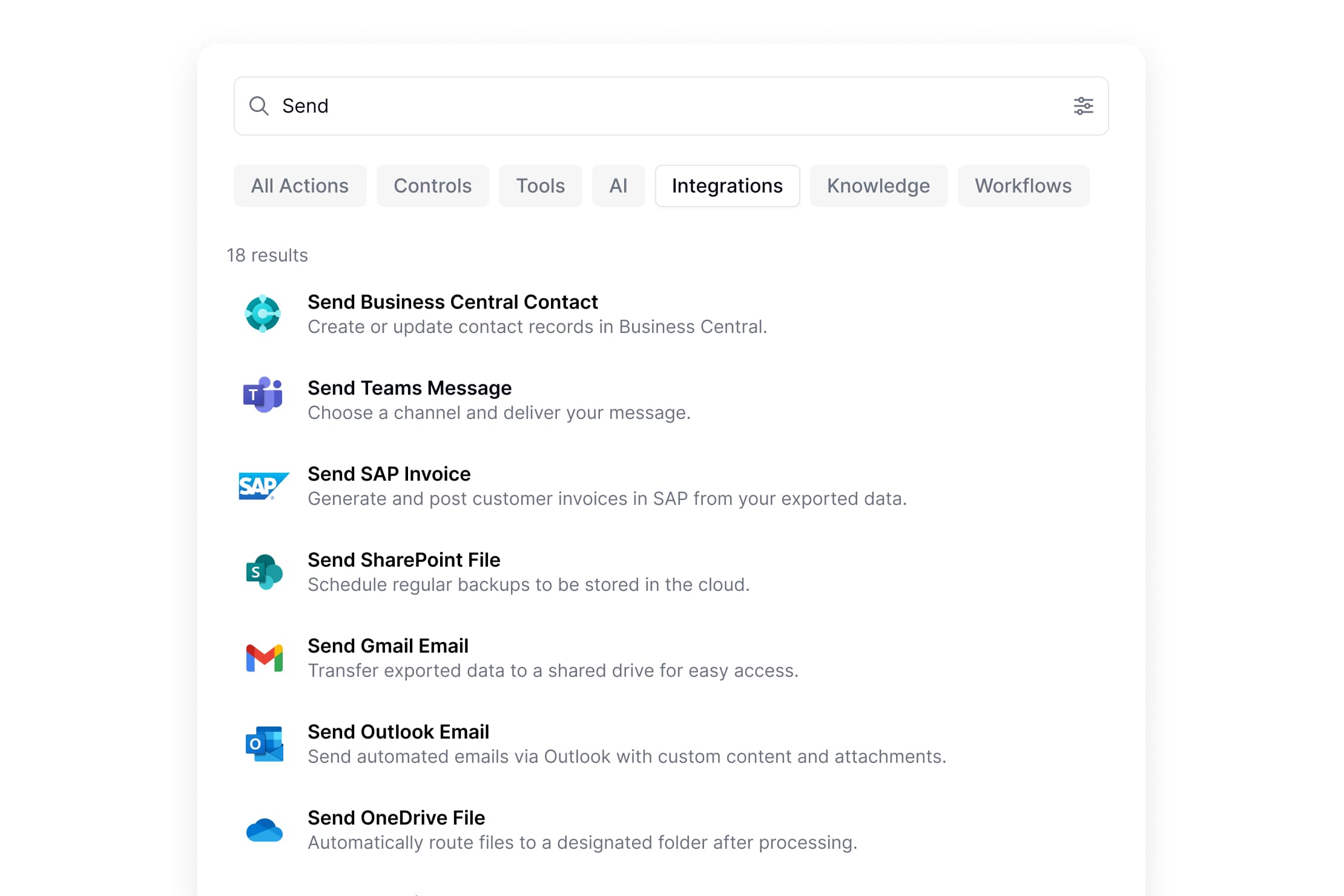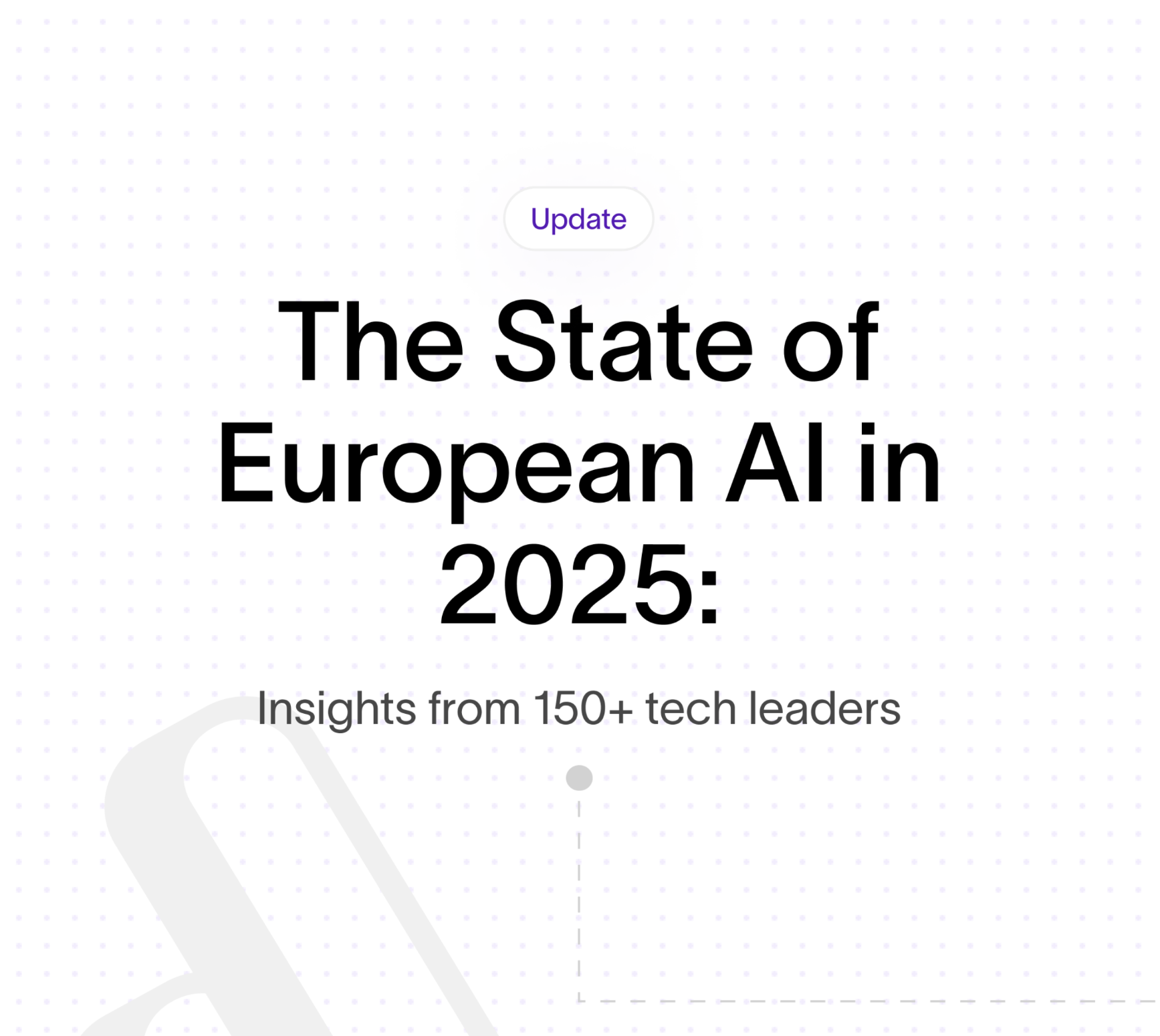The €500K Question: What Your ERP System Isn't Telling You About Its Hidden Costs in 2025
Your Business Central, SAP, or Dynamics 365 F&O system works fine... until you calculate what manual processes actually cost. European manufacturers are losing €500K+ annually on "ERP gaps" they don't even know exist. Here's how to identify and close them.

Your €300,000 ERP system, whether it's Business Central, SAP S/4HANA, Dynamics 365 F&O, Infor, AFAS, or Navision, or any other, might be costing you more than you spent implementing it.
Not because the software is bad. The problem is what happens around your ERP. In the gaps. Where your team still manually enters orders, extracts data from PDFs, reconciles information across systems, and performs the same tasks your expensive enterprise software was supposed to eliminate.
A Dutch manufacturer recently calculated the real cost of their "working fine" Business Central system. After accounting for manual workarounds, data re-entry, error correction, and lost opportunities, they discovered they were hemorrhaging €543,000 annually not because their ERP failed, but because it couldn't handle the messy, real-world processes that define modern business.
After analyzing over 150 European businesses running major ERP systems, a pattern emerged that's costing companies between €200,000 and €900,000 per year. The culprit? The expensive manual processes that exist because traditional ERPs, even modern cloud-based ones, simply weren't designed to handle today's complexity.
Why Your Million-Euro ERP System Still Requires Manual Labor
7:00 AM at a mid-sized European wholesale distributor running Business Central: Orders flood the inbox. PDFs from Germany. Excel files from France. Plain-text emails from customers. Maybe even one sends photos of a handwritten order form.
8:30 AM: Five inside sales staff begin their daily ritual. Open email. Download attachment. Manually extract article codes, quantities, delivery dates. Switch to Business Central. Re-type everything. Check stock. Calculate delivery times. Update customer. Repeat 200+ times daily.
By 11:00 AM, they're already behind. A misread article code means incorrect shipment. A Dutch customer's "Week 40" delivery request gets misinterpreted. An order with legacy article codes sits in limbo.
This scene plays out daily across thousands of European businesses. The 2025 data tells the story: The Europe enterprise resource planning (ERP) market is projected to rise with a CAGR of 8.91%, yet 64% of ERP implementations take over six months and 57% face cost overruns.
Why? Because traditional ERPs excel at structured, repetitive transactions but struggle with the unstructured, context-dependent work that dominates modern operations.
The Real Numbers: Breaking Down Your €500K+ Annual ERP Tax
Let's quantify the invisible costs. These aren't hypothetical: they're based on actual measurements from European businesses that finally calculated what their "working fine" systems actually cost.
Manual Data Entry: €180,000-€280,000 Annually
Manual data entry errors cost an average of $50 to correct, and with a typical 4% error rate on 10,000 monthly transactions, this amounts to $240,000 (€220,000) in annual losses.
But direct error correction is just the beginning:
Time Hemorrhage: Your Order Operations Manager earns €75,000 annually. Spending 3 hours daily on manual ERP updates equals €28,181 annually per person. Scale across your inside sales team: €150,000+ in pure labor costs.
Opportunity Cost: Every hour typing orders is an hour not spent negotiating with suppliers or upselling customers. For wholesalers processing 5,000 orders monthly, lost revenue opportunity exceeds €80,000 annually.
Error Multiplication: That 4% error rate doesn't just cost €50 per fix. It triggers rush shipments (€200+), returns (€500+), and damage control. Real cost: €350,000 when accounting for cascading effects.
Integration Gaps: €120,000-€200,000 Annually
Your ERP doesn't exist alone. You've got CRM, eCommerce, supplier portals, logistics systems. Disparate systems create data silos where information is isolated and inconsistent, making it difficult to maintain accuracy.
Real costs:
- Daily reconciliation: 1.5 hours daily costs €32,000 annually in direct labor
- Delayed decisions: Waiting for data from silos costs €75,000 annually in lost opportunities
- Customer frustration: Integration issues drive attrition costing €45,000 annually
The "Good Enough" Automation Tax: €90,000-€180,000 Annually
58% of organizations use automation for SAP S/4HANA migrations, with 56% reporting "medium automation"—a mix of manual and automated processes. That remaining 80% of complex work stays manual.
Consider invoice processing. Your ERP automates standard invoices. But exceptions likeunexpected line items, new suppliers, and pricing discrepancies get handled manually. Automation can cut AP processing time and costs by up to 80%, yet failing to capture half of available 2% early payment discounts on €10 million spend costs €100,000 annually.
Exception handling costs:
- AP staff time on manual invoices: €65,000
- Lost early payment discounts: €85,000
- Late payment penalties: €12,000
- Audit overhead: €18,000
Total Annual "ERP Gap Tax": €490,000 to €900,000
You're already paying it. The money leaves your business monthly. You've just been treating it as "normal operating costs."
Why Traditional ERP Integration Has Failed
If costs are so obvious, why haven't companies solved this? They've tried:
More ERP Customization: €150,000-€500,000 for significant customization, 6-18 months timeline, low success rate. ERP customizations create technical debt, complicate upgrades, and require specialized expertise. That €200,000 customization becomes a €50,000/year maintenance burden that still doesn't handle exceptions.
Buy More Software: €50,000-€200,000 for additional tools, 3-12 months timeline. Companies add WMS, planning tools, RPA solutions. Result? More integration challenges, more complexity. The gaps just shift.
Hire More People: €60,000-€80,000 per employee annually. Scaling manual processes treats symptoms, not causes. Plus, only 26% of employees fully utilize ERP capabilities: expensive talent doing work that should be automated.
Traditional RPA: €80,000-€250,000 implementation, 4-9 months timeline, 30-40% success rate. RPA is brittle, breaks with changes, requires specialists. Integration and multi-dimensional complexity remain top challenges. Works for repetitive tasks, but real business operations? Not so much.
What Actually Works: AI-Native Process Automation
Something fundamental changed in late 2024: AI systems became good enough to understand context, handle exceptions, and make judgment calls that previously required human intelligence.
Unlike traditional automation requiring explicit programming, AI-native automation can:
- Read and understand documents in any format
- Extract relevant information even when layouts vary
- Apply business rules with context-awareness
- Handle exceptions intelligently
- Learn from corrections without reprogramming
- Integrate with any ERP via modern APIs
Real Example: Koninklijke Dekker
A 140-year-old wood company faced manual order processing consuming enormous resources with Excel sheets, PDFs, and text emails requiring significant interpretation.
After implementing AI automation, they eliminated hours of manual interpretation, dramatically improved order processing speed, and enhanced data quality across departments. "Since we implemented this solution we particularly see an improvement in our data quality, not only in our inside sales department but also in our manufacturing and logistics department, we simply see that we make fewer mistakes and can work more accurately."
The New Capability
Modern AI automation platforms work differently:
For Order Processing: AI reads orders like your best employee: extracting article codes, quantities, and delivery dates from any format, even casual emails saying "just do twice that article number."
For Document Processing: AI understands meaning. It knows "Totaal excl. BTW" and "Net Amount" and "Summe netto" all mean the same thing, regardless of format.
For Complex Workflows: AI orchestrates entire business processes end-to-end, making decisions based on context, escalating only genuine exceptions, and learning from every interaction.
Closing the ERP Gap: Your 30-Day Action Plan
Based on successful implementations across Business Central, SAP S/4HANA, Dynamics 365 F&O, Infor, AFAS, and Navision:
Week 1: Quantify Your Real Costs
Track time spent on manual processes for one week. Calculate error rates and resolution costs (use 4% benchmark). Estimate opportunity costs. Most companies discover they're losing €300,000-€700,000 annually.
Week 2: Map High-Impact Processes
Focus on:
- Order Processing if you process 500+ orders monthly from multiple channels
- Invoice Processing if AP staff spend 30%+ time on manual handling
- Quote Generation if quotes require data from multiple systems
- Data Transformation if constantly moving data between systems
Prioritize: High Impact + High Frequency = Start Here
Week 3: Select Your Approach
AI-Native Integration Platform (Recommended)
- Timeline: 4-6 weeks to first production workflow
- Investment: €30,000-€80,000 first year
- Example: Lleverage enables business experts to automate knowledge-intensive processes without technical complexity
Alternative: ERP-Native AI
- Often included in licenses but limited functionality
- By mid-2026, 60% of large organizations will have redesigned workflows around AI, but native ERP AI typically handles only structured scenarios
Week 4: Pilot Implementation
Phase 1 (Week 1): Connect AI automation with read-only access. Process 50 transactions parallel to existing process.
Phase 2 (Weeks 2-3): AI creates drafts, human team reviews and approves. Track time savings and error reduction.
Phase 3 (Week 4+): AI handles standard transactions automatically. Intelligent escalation for exceptions only.
Expected Results:
- 75% faster processing
- Zero errors on standard orders
- 60-70% reduction in manual data entry
- 85-90% of transactions handled without human intervention
Months 2-3: Expand and Optimize
Once your pilot proves ROI (typically 4-6 weeks):
- Automate adjacent processes in same workflow
- Replicate to other departments
- Tackle complex exception scenarios
- Build AI-powered decision support
By Month 3:
- 50-70% reduction in manual process costs
- €150,000-€400,000 in annualized savings
- Foundation for continuous expansion
Industry-Specific ERP Gap Scenarios
Manufacturing: Production Planning
The Gap: Effective inventory management helps manufacturers balance stock levels, but external pressures like demand fluctuations and supply chain disruptions complicate coordination.
AI Solution: Production and capacity planning automation ingests customer requirements in any format, validates against real capacity, coordinates with suppliers automatically, and updates ERP with optimized schedules.
ROI: A Dutch manufacturer processing 200 custom orders monthly saved 450 hours annually, reduced stockouts by 73%, and improved on-time delivery from 81% to 96%.
Wholesale: Multi-Channel Orders
The Gap: Orders arrive via EDI, email, phone, portals, and mobile apps. Your ERP expects structured input. Traditional automation handles EDI. Everything else? Manual.
AI Solution: Order processing automation understands orders in any format, matches legacy article codes, applies customer-specific pricing, checks inventory across warehouses, and creates ERP orders automatically.
ROI: A European distributor processing 1,200 orders weekly reduced order entry time by 78% and eliminated article code errors, freeing €285,000 annually.
Professional Services: Quote Generation
The Gap: Creating quotes requires pulling data from ERP (pricing), CRM (customer history), project management (resource availability), and external sources (material costs).
AI Solution: Quote generation automation assembles information from multiple systems, applies pricing logic and historical learning, generates client-specific proposals, and routes for approval.
ROI: An engineering consultancy reduced quote generation from 2.5 hours to 15 minutes, increased quote volume by 140%, and improved win rate by 12%.
Common Implementation Failures (And How to Avoid Them)
"Boil the Ocean" Approach: Trying to automate everything at once with 18-month plans.
Solution: Start with one high-value process. Get it working in 4-6 weeks. Prove ROI. Then expand.
Technology-First Thinking: "We need AI" without clear business objectives.
Solution: Define success in business terms first: "Reduce order processing time by 70%" or "Eliminate invoice errors." Then choose technology.
IT-Only Ownership: Treating automation as an IT project without business user involvement. One of the biggest ERP implementation challenges is getting users and functional groups to change their ways.
Solution: Create hybrid teams with business process owners as primary stakeholders, IT as enablers.
Under-Estimating Change Management: Minimal training, surprise rollouts. The introduction of AI tools triggers concerns about job security and well-being.
Solution: Overcommunicate. Involve end users in pilot testing. Show how automation removes tedious work and enables more interesting challenges.
No Executive Sponsorship: Mid-level initiative without C-suite support.
Solution: Calculate the full cost of your ERP gaps. Present to executive leadership with clear ROI projections. Secure explicit sponsorship before starting.
The Bottom Line: Your €500K Decision
Your ERP system cost €200,000-€500,000 to implement. You pay 15-20% annually in maintenance. Yet you're losing €200,000-€900,000 annually because it can't handle modern business complexity.
The choice isn't whether to automate these gaps. The choice is whether to be among the first wave of European businesses capturing this opportunity or watching competitors pull ahead.
The Netherlands has positioned itself as Europe's AI automation leader with 95% of organizations running AI programmes. This advantage compounds over time: data quality, process optimization, and competitive positioning all benefit from early action.
Traditional approaches (more customization, more software, more people) don't solve the problem. They just shift costs.
AI-native process automation—the kind that understands context, handles exceptions, and integrates seamlessly with existing ERPs—solves it. Companies implementing these solutions see:
- 50-80% reduction in manual process time
- 85-95% error elimination
- €150,000-€600,000 in first-year savings
- Foundation for continuous operational improvement
More importantly, they free talented staff from data entry to focus on judgment, strategy, and human relationships... the things that actually create competitive advantage.
Your ERP isn't going anywhere. Business Central, SAP, Dynamics 365 F&O, Infor, AFAS, and Navision will continue running core operations. But the gap between what your ERP does and what your business needs? That gap has a solution now.
The question is "How quickly can we start?"
Frequently Asked Questions
How long does it take to see ROI from AI automation?
Most companies see measurable results within 4-6 weeks of starting a pilot. Full payback on investment typically occurs within 6-9 months, with ongoing savings accumulating thereafter. By the first month, businesses typically achieve 75% faster processing and zero errors on standard orders.
Will this work with our heavily customized ERP?
Yes. Modern AI automation platforms integrate with heavily customized on-premise systems as long as API access exists, mapping custom fields and respecting specific workflows. Integration happens outside your ERP, so customizations don't matter as long as standard APIs or web services are available.
What happens when our ERP vendor releases updates?
Because AI automation integrates via APIs rather than deep customizations, ERP updates don't break automation. This is a key advantage over traditional customization approaches that require rework with every upgrade.
Do we need technical people to maintain AI automation?
No. Modern platforms are designed for business users. With platforms like Lleverage, describing the problem is all it takes to begin solving it. IT involvement is minimal after initial integration setup.
What about data security and GDPR compliance?
Choose platforms with SOC 2 Type II, ISO 27001, and GDPR compliance. Lleverage ensures zero data retention by third-party AI providers with sensitive information processed in real-time and immediately purged. EU data residency options ensure data never leaves Europe.
What happens to our staff when we automate their work?
Successful implementations redeploy staff to higher-value activities: customer relationships, exception handling, process optimization, strategic projects. AI technology elevates roles by allowing staff to manage more complex tasks. Companies typically see improved job satisfaction as tedious work disappears.
How much does AI automation actually cost?
For a mid-sized European business automating 2-3 major processes:
- Implementation: €30,000-€80,000 first year
- Ongoing: €20,000-€50,000 annually
- Payback Period: 6-9 months typical
- 3-Year ROI: 400-800% for well-executed implementations
Compare this to the €200,000-€900,000 annual cost of NOT automating.
Ready to Calculate Your Specific ERP Gap Cost?
Book a 30-minute consultation with our solution architects to walk through your current processes and calculate your exact annual ERP gap cost. We'll also show you how companies with your ERP system (Business Central, SAP, Dynamics 365 F&O, Infor, AFAS, or Navision) are closing these gaps with AI automation.
Zero obligation. Just honest analysis of where you're losing money and how to stop it.
Related Resources:

.jpg)



